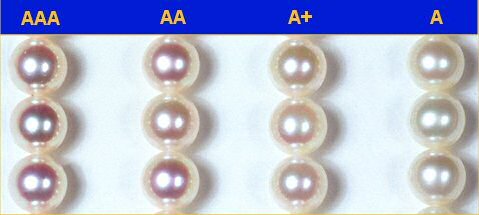Pearl GradingThe following criteria is important to assess the quality of a pearl: 1. size:The size of a pearl is the only feature visible for every viewer. it is measured in millimetres. There are pearls measuring a few millimetres only while South Sea pearls can reach a size of 20 millimetres diameter. Generally speaking, a larger pearl is more precious than a smaller one, while all other criteria have to be similar. 2. shape:The shape of cultured pearls is generally divided into round, symmetric and baroque. Round shapes: almost and perfectly round To find a perfectly round pearl is extremely difficult.
The closer the pearl’s shape is to a perfect round, the more valuable
it is. In the end, preferences depend on the individual taste.
3. colour:To judge the colour of pearls, a basic tone, luminosity and colour depth is considered. Akoya pearls show a spectrum covering shades of white, cream or soft pink. South Sea pearls shimmer in white, silver, pink or gold. Tahitian pearls are famous for their dark shades. A light grey is found, as well as gold, black-green to black.
4. luster:The Iridescence of pearls is called ‚luster’
or ‘Orient’. Pearls show this glamorous play of colours in
delicate nuances due to the bow in their surface, enabling us to perceive
their brilliance from every angle. The interaction of light rays and surface
creates the iridescence, the so called ‘surface colour’ visible
as a small circle on the pearl’s outer layer of nacre. The luster
depends on the thickness of nacre, numerous layers encasing the nucleus.
The layers of nacre act like tiny prisms, refracting light, so it appears
as all the colours of a rainbow.
|


30 Day Money Back Guarantee
No Shipping Fees-
Your Shopping Basket is empty










